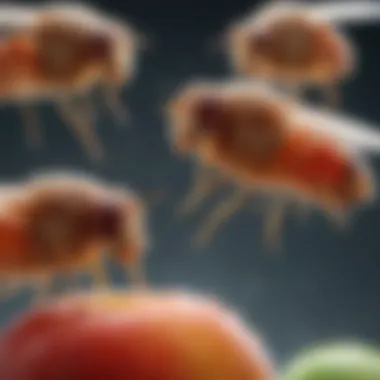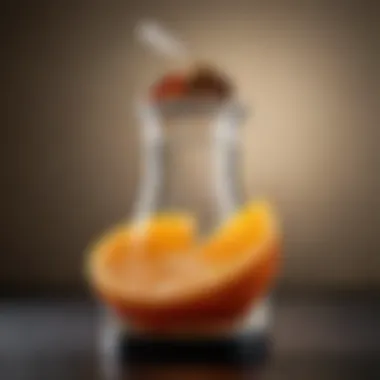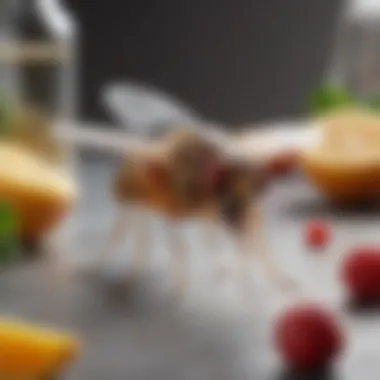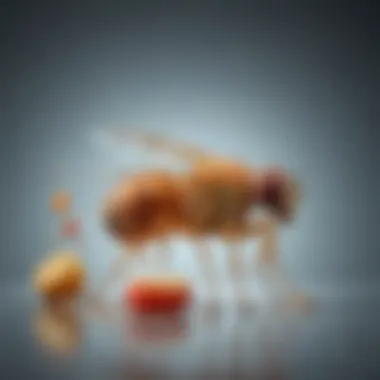Effective Strategies for Eliminating Indoor Fruit Flies


Intro
Fruit flies, small yet tenacious, often become unwanted guests in homes. Understanding their breeding habits and effective control methods can shield your living space from these nuisances. This segment will lay the groundwork, providing insights on their biology and behaviors.
Fruit flies thrive in warm conditions, particularly where decomposing food is present. They are drawn to ripe fruits, neglected vegetables, and moist organic materials. Even a small piece of food can attract these pests, allowing them to breed quickly, thus exacerbating the challenge of control. Knowing this, identifying potential breeding grounds is essential in your eradication strategy. In the following sections, various proactive measures and targeted methods will be explored.
Next, the thorough breakdown starts with prevention tactics and extends into a variety of effective killing methods. No single approach may be sufficient alone, but a combination can effectively reduce fruit fly populations.
Prevention Strategies
Maintain Cleanliness
Fruit flies establish themselves where food is in abundance. Regularly cleaning kitchen surfaces should be a main priority. Here are a few appropriate measures:
- Store overly ripe or rotting fruits and vegetables in sealed containers.
- Clean spills immediately; syrupy substances attract these insects.
- Empty trash bins often and consider covering them with lids.
Discard Potential Breeding Sites
Go through your kitchen to identify potential breeding grounds. Pay particular attention to:
- Drains: Remove organic debris regularly.
- Cabinet corners: Ensure there are no forgotten/sustained food sources.
Control Moisture
Fruit flies favor humid areas for breeding. Limit sources of moisture, paying special attention to:
- Dish towels: Always dry them out to avoid adding moisture level.
- Sink areas: Dry these off before and after use.
Using these measures helps minimize the number of fruit flies significantly. Without suitable breeding sites, their populations struggle to thrive.
Targeted Control Methods
Various strategies can aid in eradicating existing fruit flies. They range from DIY traps to store-bought pesticides.
Homemade Traps
Simple yet effective, some home ingredients are valuable in catching fruit flies. Here are some suggested strategies:
- Apple Cider Vinegar Trap: Fill a bowl with apple cider vinegar and cover it with plastic wrap. Poke small holes on top for flies to enter; however, escape is hard once caught inside.
- Wine Trap: Pour leftover wine into a glass jar and cover it with plastic wrap with small perforations. Much like vinegar, they are lured by the smell.
Store-Bought Solutions
For effective instant results, select specific commercial products. Consider items such as:
- Pesticidal sprays labeled for indoor use that target fruit flies directly.
- Sticky traps designed to catch various pests, easily found in stores.
Always ensure that chosen products are safe for indoor use and follow all instructions carefully to ensure efficacy.
Using these targeted approaches effectively will create a barrier against developing populations after addressing those already inside. With a thorough understanding and implementation of these methods, a more comfortable indoor mood can be achieved.
Understanding Fruit Flies
Understanding fruit flies is vital for managing their presence indoors. This section assists in grasping essential elements of their biology, influences on behavior, and the impact that an understanding of their traits has on control methods. By comprehending these fundamentals, individuals can increase prevention efforts and reduce the likelihood of infestations.
Biology and Behavior of Fruit Flies
Fruit flies, scientifically known as Drosophila melanogaster, possess distinct biological characteristics. They can be identified by their small size, typically ranging from 1/8 inch in length, and by their tan-colored bodies, which may include distinctive red eyes.
Their behavior characteristically revolves around seeking out rotting or fermenting foods. This attraction stems from their diet preferences, which primarily consist of plant material. Notably, this behavior aids in decomposition, a process essential in natural ecosystems. However, when they invade homes, their attraction to ethylene gas emitted by ripe fruits presents a complication.
As fruit flies mature, they exhibit specific behaviors that see them rapidly walking and flying around food sources. They tend to breed in abundance. Monitoring these behavior patterns can inform strategies for disrupting their habits and guiding targeting elimination efforts.
Lifecycle of Fruit Flies


The lifecycle of fruit flies is key to understanding how to tackle infestations. Commencing from the egg, they progress through larval and pupal stages before becoming adults. This lifecycle can unfold within just a week under favorable conditions. Knowing this timeline enables more effective control that restricts them while they are at vulnerable development stages.
- Egg: Laid in batches, these eggs are tiny and hard to see.
- Larva: Emerges from the egg, it feeds voraciously on decaying matter, gorging on substances conducive to their growth.
- Pupa: Transitioning to this stage marks a crucial change from larva to adult. It’s during this transformative period that their vulnerability peaks.
- Adult: The familiar sight of fruit flies appears after about eight days.
An understanding of these stages aids in recognizing the life patterns that can lead to comprehensive control measures.
Common Species of Fruit Flies
While Drosophila melanogaster is prevalent, it's not the only species that enters homes. Different species may appear based on specific environmental factors. Some notable ones include:
- Drosophila suzukii: Also called the spotted wing drosophila, it possesses a unique identification feature with black spots on its wings.
- Ceratitis capitata: This is known as the Mediterranean fruit fly, primarily affecting citrus.
By identifying species presented, guidance strategies can be tailored. These specific species may respond differently to various elimination tactics, ultimately assisting in creating more effective pest control measures.
Identifying Fruit Fly Infestations
Identifying fruit fly infestations is crucial for effective management. Recognizing the signs early enables immediate action before numbers escalate. Ignoring these signs can result in an established population, leading to more complex control challenges.
Benefits of identification include:
- Developing a precise strategy for elimination.
- Reducing the extent of unsanitary conditions.
- Enhancing overall household cleanliness and appeal.
Observing specific signs and understanding common breeding ground will facilitate proactive measures to keep your environment free of these pests.
Signs of Infestation
Signs of fruit fly infestations are often subtle. Therefore, being attentive to your surroundings proves essential. Commonly, you may notice fruit flies buzzing around overripe fruit or vegetables. They are adept at finding any organic substance that has begun to ferment or decay.
Other indicators include:
- Adults Flies: Spotting small flies (around 1/8th inch long) hovering close to ripening foodstuffs. Their tan or brown bodies are distinct, making them easy targets for the observant eye.
- Larvae: These fly larvas might be more challenging to detect. They tend to be whitish and are often found in debris or organic matter, particularly near overripe fruits or inside drain systems.
- Residuals: Look for sticky residues or organic matter left behind. These can signify previous infestations, showing where flies have laid eggs.
The sooner you recognize these signs, the more effectively you can address the problem.
Common Breeding Grounds
Understanding where fruit flies breed helps in managing them effectively. Common breeding grounds include:
- Kitchen Areas: Fruit flies thrive near countertops, sinks, and trash bins. Any spot where food waste is present can attract them. This includes under appliances where spills might easily go unnoticed.
- Ripening Produce: Enticing for fruit flies, ripe or rotten fruits often become breeding hotspots. Therefore, storing fruits properly reduces the chances of infestation.
- Beverage Containers: Half-empty bottles of beer or wine, as well as juice cartons, can draw these pests. Residual sugar or yeast makes these locations highly attractive for fruit fly breeding.
- Compost Bins: Organic waste composters create a haven for these insects if not properly maintained.
In summary, prudent observation and immediate responses to signs can mitigate infestations early. Recognizing breeding locations also assists in designing preventative strategies to keep your house less hospitable to fruit flies.
Prevention Techniques
Preventing fruit flies from invading your home is crucial for maintaining a clean and sanitary environment. Effective prevention techniques not only minimize the risk of infestation but also reduce the necessity of interventions later. By implementing well-informed practices, you can protect your living spaces from these persistent pests.
Proper Food Storage
Proper food storage plays a vital role in obstructing fruit flies’ access to potential breeding materials. Store fruits and vegetables in the refrigerator when possible. Doing so delays the ripening and reduces sugar content that attracts flies. Sealed containers can also inhibit access by keeping odors contained.
- Use airtight containers for specific items like grains and baked goods. This hindrance drastically cuts down on potential attractants.
- Keep produce clean and separated. Regularly check your storage areas to eliminate any overly ripened items. Decomposing produce invites fruit flies, making frequent inspection essential.
Proper food storage not only reduces the risks related to these pests but also minimises food waste, as it encourages better management of perishable items.
Waste Management Practices
Another crucial component of prevention relates to waste management. Proper disposal and maintenance of waste areas shield your home from inviting infestations. Start by ensuring waste bins have tight lids to contain odors and are regularly emptied.
Here are some important steps:
- Dispose of food scraps immediately. Don't leave peels or leftovers sitting out, as these attract fruit flies quickly.
- Regular cleaning of disposal areas is essential. Fruit residue can accumulate in compost bins and garbage disposal units if not addressed promptly. Clean these places to prevent any collection of decaying organic material.
- Use compost with care. If you compost at home, manage contributed materials extravagantly. When transitioning organic waste to compost, do it in small quantities and cover it immediately.
By prioritizing waste management practices, you eliminate unnecessary attractants and break the cycle of infestation at its source.
Housekeeping Tips


Moreover, maintaining a structured and clean environment goes a long way toward preventing fruit fly swarms. Comprehensive housekeeping routines oscillate between regular cleaning and particular focus on outriggers highly susceptible to attractants.
Key housecleaning strategies include:
- Regularly wipe down incriminating surfaces. This means counters, tables, and sinks to clear residues from prolong exposure of food then eliminate the possibility of attracting flies.
- Maintain cleanliness in entry points. Accountancy for screens and doorways to make sure bugs cannot get inside. Assess these barriers consistently, ensuring no gaps are unfilled.
“An ounce of prevention is worth a pound of cure.” Keeping an orderly house not only enhances aesthetics but also diminishes instances which invite pests.
- Check and tidy up liquid spills promptly, particularly sugary substances which are double exponentially attractive to fruit flies.
Engaging in well-thought-out housekeeping will notably prevent fruit regions from becoming fertile ground for these nuisances. Continually monitor and adjust your cleaning habits to neutralize vantage points for these insects, ensuring long-lasting success in keeping them at bay.
Removing Attractants
Removing attractants is a crucial step in the fight against fruit flies indoors. These pests predominantly feed on sweet and fermenting substances. Comprehensively understanding and reducing their initial lure can significantly decrease their presence in any residential setting. This approach targets the heart of their sustenance, thereby diminishing the likelihood of an infestation.
Cleansing Surfaces
A clean environment is vital for managing fruit flies. They thrive in areas that provide food particles for feeding and breeding. Regularly cleansing surfaces in the kitchen is paramount. Wipe down counters and tables with appropriate cleaners. Pay particular attention to areas that may accumulate spills or crumbs, like the seams of kitchen appliances or the dining table.
Consider using a vinegar and water solution for organic cleaning. This not only removes residues but also gives a strong deterrent scent for those little flies. Be especially vigilant with surfaces near fruit bowls and garbage cans. Establish cleaning routines to promote an ongoing preventive strategy.
Doing generally light cleans daily can make an impact, with deeper cleans of the entire kitchen at least once weekly.
Managing Ripened Produce
Finding ways to manage ripened produce is also essential for deterring fruit flies. Many folks enjoy ripe fruits, but uncontrolled amounts can invite pests.
- Proper Storage: Store fruits and vegetables in the refrigerator when they become overly ripe. Cold temperatures considerably slow their ripeness, thus limiting the temptations for fruit flies.
- Regular Check: Examine your stash of consumables regularly to ensure nothing is spoiled or overripe. If you notice anything compromising, disposal should happen right away.
- Use Sealed Containers: For any fruit that needs lime, consider keeping it secure in sealed containers. This action allows you to serve these food items while blocking any welcoming smells for flies.
The negotiation between savoring fresh fruits and defying insects lies in effective management of how you handle them in your home.
Effective Traps
Effective traps represent a crucial component in the quest to combat fruit fly infestations indoors. These nuisances are not only irritating but can contribute to unsanitary conditions and undermine the cleanliness of your living spaces. Understanding the importance of traps can empower residents to take purposeful action, capturing the insects swiftly and hindering their potential to repopulate.
Traps act on attraction principles, luring fruit flies with scents that mimic their natural preferences. When employed effectively, these devices can significantly diminish the fruit fly population, providing immediate relief to homeowners. The benefits of using traps include their ease of use, relatively low cost, and the ability to monitor infestations. Moreover, they can be part of a broader management strategy that combines prevention with removal, enhancing the effectiveness of your overall approach.
DIY Fruit Fly Traps
Creating DIY fruit fly traps can be a practical and effective strategy for managing these pests. Common household ingredients are often all that is needed, and these traps can be constructed with very little time or resources.
One popular method involves combining apple cider vinegar with a few drops of dish soap in a bowl. The vinegar attracts the flies, while the soap breaks the surface tension, leading them to drown. You can also make use of a plastic bottle by cutting it in half and placing the top inverted into the bottom part, with some vinegar inside. The flies enter but struggle to escape.
Another approach is using a piece of ripe fruit, placing it in a covered jar with small holes. Flies can get in, but it will be difficult for them to leave. This allows for simple trapping using common ingredients found in your home, hence making it easily accessible.
These DIY traps not only help in catching flies but also provide an environmentally friendly alternative to chemical treatments. They can help reduce the sugar-intensive lures, promoting hygiene and lessening unwanted residuals in your cooking space.
Commercially Available Traps
For those seeking a more streamlined and professional solution, commercially available traps are widely accessible in stores and online. These products often incorporate custom lures and adhesive mechanisms specifically designed for effective atrraction and capture of fruit flies.
Brands such as TERRO offer dedicated fruit fly traps that utilize an effective bait system to lure the flies in, promoting maximum capture rates without the fuss of making traps at home. Sticky traps are another well-known option, providing a simple yet efficient way to reduce fruit fly presence by capturing them on an adhesive surface.
When considering commercial traps, factors such as ease of use, effectiveness, and design are essential. Many of these traps provide a more aesthetic presentation to fit modern kitchen designs. Moreover, they eliminate the need for ongoing monitoring and replacement.
While priced higher than DIY methods, commercially available traps save time and often deliver better outcomes due to their advanced formulations.
Effective fruit fly traps serve as both a proactive and reactive measure in controlling infestations, bridging the gap between prevention and removal strategies.
Chemical Control Options
Dealing with fruit flies requires a multifaceted approach. One part of that is chemical control options. These methods can swiftly reduce the fruit fly population, but they come with their own set of pros and cons.
Chemical control can be effective for quick intervention when faced with a serious infestation. These sprays and pesticides target the flies directly. The immediate effect helps in minimizing the breeding population. Moreover, the systematic application can suppress future generations. However, certain considerations should not be overlooked when deciding to use chemical methods. Organic options exist and they could be safer for food preparation areas.


Insecticidal Sprays
Insecticidal sprays remain a common choice for mitigating fruit fly issues indoors. These products generally contain active ingredients that are specifically designed to eliminate adult flies upon contact. It is critical to select sprays labeled for indoor use since some products are formulated exclusively for outdoor applications.
When applying insecticidal sprays, adhere to the following guidelines:
- Read the label closely: Ensure the product can target fruit flies.
- Apply in areas of activity: Focus on places where flies are frequently seen, such as kitchens and dining areas.
- Be cautious of surfaces: Some insecticides may harm surfaces where food is prepared. Consider using a small amount first on a concealed area.
- Observe safety practices: Maintain distance while spraying and allow for sufficient ventilation post-application.
Moreover, combine sprays with other strategies like traps for comprehensive management.
Natural Pesticides
Natural pesticides present an eco-friendlier alternative to traditional insecticides. These are derived from natural sources and often pose less risk to human health and pets. Some common natural pesticides designed to control fruit flies include neem oil and pyrethrins.
Advantages of natural pesticides include:
- Lower toxicity: As they are derived from botanicals, they usually exhibit lower risks for human proximity.
- Less environmental impact: Their natural formulation offers a greener approach.
- Biodiversity friendly: By minimizing harm to beneficial insects, natural pesticides help maintain ecological balance.
Utilizing natural pesticides might also entail careful and strategic application. Consider these recommendations:
- Mix and match: Combine natural pesticides with traps to increase efficacy.
- Frequent applications: Due to biodegradable properties, repeat application may be necessary.
- Physical proximity in spraying: Effective use sometimes depends on contact with the insect so ensure proper method of application.
It's essential to weigh options carefully, especially regarding safety and environmental impact, prior to selecting a product.
Post-Elimination Strategies
Post-elimination strategies are crucial for keeping fruit flies from returning after an initial control effort. Even if fruit flies are eradicated, their predisposition to invade spaces where there is organic matter or stagnant water makes these strategies essential. This section highlights the importance of being vigilant and maintaining an infection-free environment. It emphasizes two main components: close monitoring for recurrence and establishing long-term maintenance practices.
Monitoring for Recurrence
Monitoring for recurrence involves a series of actions that help identify any return of fruit flies after they've been removed. Setting up a regular inspection routine can save significant time and effort in the future. Key actions include:
- Regularly checking areas that attracted fruit flies before, such as kitchens or garbage disposal sites.
- Using sticky traps around previously infested zones to capture any lingering or newly entering flies.
- Observing any noticeable smells that may indicate decaying material or breeding sites.
It is beneficial to document any spots that draw fresh activity or traps that collect flies. This ongoing surveillance will inform any adjustments in eradication methods or monitor treatment frequency.
“Prevention is always better than cure.” – This adage holds true for fruit fly issues as any signs of pests should not be weeded out but learned and left monitored closely.
Long-Term Maintenance Practices
Long-term maintenance practices play an integral role in managing the environment to deter fruit flies. Once flies are evicted, actively maintaining the cleanliness of spaces can make a significant difference. Strategies to employ include:
- Regularly cleaning surfaces to ensure that food particles are eliminated.
- Sealing food in airtight containers to hisust them.
- Making necessary repairs to areas where moisture accumulates, such as under sinks or bathtubs.
- Implementing compost practices away from living areas, which can illegally attract flies.
Utilizing these practices promotes a streamlined, fly-repelling environment and increases awareness of every possible fruit fly lure. Designing efficient maintenance protocols establishes an inclusive approach to preventing future infestations.
Ultimately, sustaining attention in monitoring and employing sustainable routines will help deter fruit flies. Stability lies in long-term maintenance with adaptive changes as necessary to encouarage a pest-free home.
When to Consult Professionals
Dealing with fruit fly infestations can be frustrating. Sometimes, your efforts may not be enough. Knowing when to consult professionals is key to effectively managing this issue. Pests thrive in environments where they can access food, moisture, and places to breed. Fruit flies, in particular, are notorious for their rapid reproduction. When the level of infestation reaches a point that you cannot control through personal means, it is advisable to seek specialized assistance.
In this section, two primary aspects will be covered: assessing the severity of the infestation and choosing the right pest control service. Both are essential in determining if and how you should rely on experts.
Assessing the Severity of Infestation
Before reaching out to professionals, it is critical to assess the severity of infestation in your home.
- Initial Signs: Noticeable signs include the presence of adult flies, fly larvae, and a distinct odor emanating from areas where they breed.
- Population Count: If you observe an increasing number of fruit flies despite your control methods, it signals a more intensive problem that might need expert help.
- Duration of Infestation: An ongoing issue that persists beyond a few weeks often requires you to take further action.
If you find yourself overwhelmed or unable to curtail their population, the severity clearly indicates that consulting experts would be beneficial.
Choosing a Pest Control Service
If you decide that professional help is needed, choosing the right pest control service is vital.
Here are several factors to consider:
- Experience: Opt for established services with proven records in dealing with fruit fly outbreaks. Their experience translates into effective strategies tailored to your issue.
- Methods Used: Inquire about offered methods. The use of non-toxic or environmentally friendly solutions might be a priority for you.
- Reviews and Reputation: Look for reviews from previous clients to gauge their satisfaction with the service provided. High ratings often point to reliability.
- Cost: While pricing shouldn’t be the only factor, ensure that the service is affordable yet provides consistent results.
With the right assessment and careful selection of a professional, dealing with an infestation of frut flies can become manageable, ensuring your living spaces remain clean and safe.







